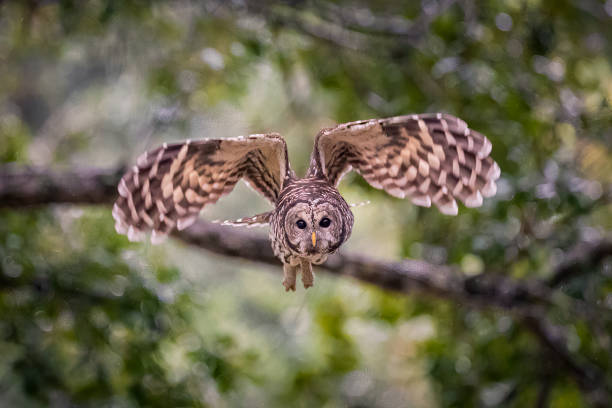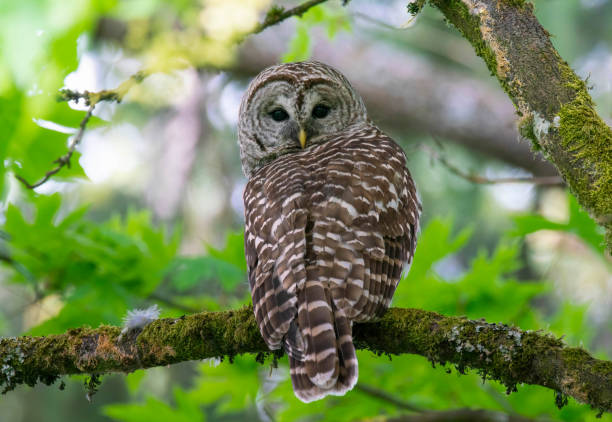Table of Contents
Scientific Classification
| Kingdom | Animalia |
| Phylum | Chordata |
| Class | Aves |
| Order | Strigiformes |
| Family | Strigidae |
| Genus | Strix |
| Species | Strix varia |
| Scientific Name | Strix varia |
1. Description
The Barred Owl (Strix varia) is truly a captivating bird. Its piercing gaze seems to slice through the shadows of the forest. With its soft feathers adorned in brown and white stripes, it carries an air of mystery. Unlike some of its owl relatives, it has a large, rounded head without those characteristic ear tufts. Instead, it boasts soulful dark eyes, which is quite a departure from the usual yellow-eyed look of many owls. These features lend it a gentle, wise appearance.
Typically, adults measure between 16 to 25 inches (40 to 63 cm) in length, with a wingspan that stretches from 38 to 49 inches (96 to 125 cm). Weighing in at around 1 to 2.5 pounds (500 to 1,150 grams), they fall into the medium-to-large category of owls. Their unique call—“Who cooks for you? Who cooks for you all?”—resonates through the forests and swamps, often becoming the enchanting soundtrack of twilight across North America.
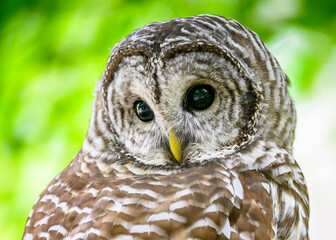
2. Distribution
Barred Owls primarily inhabit eastern North America, but over the past century, they’ve made their way to the Pacific Northwest. Their territory stretches from southern Canada, through the eastern United States, and down into northern Mexico.
As they ventured westward, they crossed the Great Plains and settled in areas that were once home to the endangered Spotted Owl. This expansion has brought about new ecological challenges and increased competition between species.
3. Habitat
Barred Owls are the quintessential forest inhabitants. They thrive in expansive, mature woodlands, particularly those that feature a mix of deciduous and coniferous trees. These forests are often found near water sources like swamps, marshes, and riverbanks. Old-growth forests are especially ideal for nesting and roosting, thanks to the abundance of tree cavities they provide.
Interestingly, Barred Owls have shown a remarkable ability to adapt to urban and suburban environments. As long as there are plenty of tall trees around, they can make it work. That said, they generally prefer to steer clear of bustling human activity.
4. Diet
Barred Owls are flexible eaters, always on the lookout for a diverse meal. Their diet features a range of small mammals like mice, voles, shrews, and rabbits. They’re also known to hunt birds, amphibians, reptiles, and even fish whenever they get the chance. Occasionally, they’ll snack on invertebrates such as insects or crayfish.
These owls primarily hunt at night, using their exceptional hearing and vision to spot prey, even in total darkness. They often perch quietly before swooping down without a sound. Their feathers are specially designed to muffle noise, making them stealthy hunters.
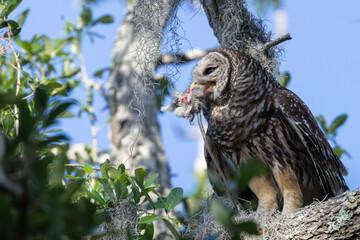
5. Behavior
Barred Owls are typically solitary creatures, fiercely guarding their territory. They only come together during mating season or when they’re raising their young. Unlike some birds, they don’t migrate, but they will relocate if food becomes scarce or if their environment changes.
Their eerie call isn’t just for show; it plays a crucial role in marking their territory and connecting with their partners. Males and females often engage in duets, which strengthens their bond. When faced with rival owls, Barred Owls might clap their beaks, hiss, or even strike with their talons to assert dominance.
These birds are quite intelligent, showcasing complex communication and a natural curiosity. This intriguing behavior has made them favorites among birdwatchers and wildlife photographers alike.
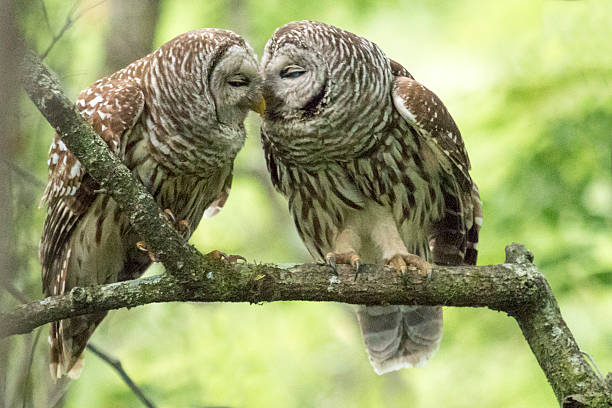
6. Lifespan
In the wild, Barred Owls typically have a lifespan of about 8 to 10 years. However, if the conditions are just right, some can live up to 18 years or even longer. When kept in captivity, they can reach ages of 23 years or more, thanks to the absence of predators and the availability of regular food and medical care.
Life in the wild can be quite perilous. Many Barred Owls don’t make it past their first year due to threats like predation or starvation.
7. Reproduction and Lifecycle
Barred Owls are known for their monogamous nature, often forming lifelong bonds with their partners. Their breeding season kicks off in February and can stretch all the way to June, depending on where they are. During courtship, they engage in a fascinating array of sounds and displays, with the male often presenting food to the female as part of their bonding ritual.
Once they’ve paired up, these owls typically choose tree cavities for nesting. They frequently take over old nests that were previously used by hawks or squirrels, rather than building their own from scratch. Instead, they simply line these existing nests with some soft materials to make them cozier. A typical clutch consists of 2 to 4 eggs, which the female incubates for about 28 to 33 days, while the male is busy bringing home the food.
When the owlets finally hatch, they’re adorably fluffy and depend on their parents for several weeks. They begin to venture out of the nest at around 4 to 6 weeks old, but they stick close by to continue receiving food and to pick up essential survival skills.
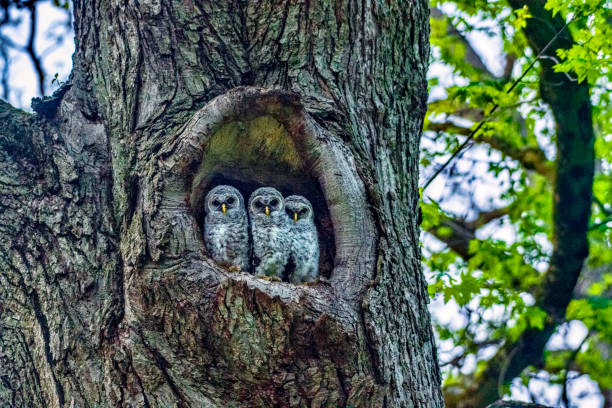
8. Predators
Even though adult Barred Owls are perched at the top of their food chain, they still face some dangers. The Great Horned Owl is likely their most significant natural threat, often engaging in fierce battles over territory that can lead to the death of Barred Owls.
When it comes to eggs and young owlets, they’re more at risk and can become targets for raccoons, hawks, and even snakes. Additionally, humans pose indirect threats to wildlife. Activities like deforestation, vehicle accidents, and the use of rodenticides can endanger their food sources.
9. Adaptations
The Barred Owl is truly a master of silent flight, thanks to the soft, fringe-like edges of its feathers. This unique adaptation allows it to glide quietly through the forest, making it a formidable predator under the cover of night.
With exceptional night vision and sharp hearing, these owls are skilled hunters, even in near-total darkness. Their asymmetrical ears play a crucial role in locating sounds with precision. Plus, their necks can swivel an impressive 270 degrees, enabling them to survey their surroundings without having to move their bodies.
Barred Owls are also quite adaptable in their behavior. While they prefer the tranquility of mature forests, they’re not shy about living near humans if there’s plenty of food and shelter available.
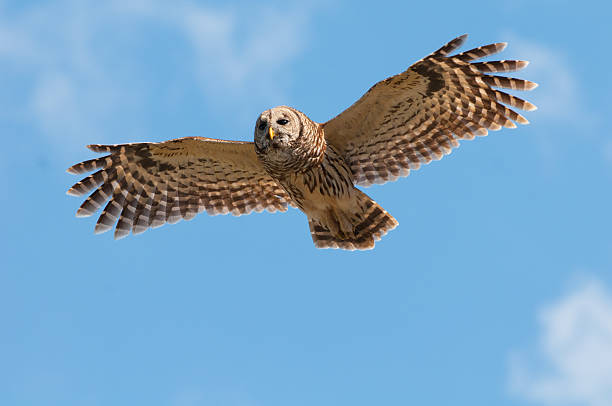
10. Conservation Status
Right now, the Barred Owl is classified as a species of Least Concern on the IUCN Red List, and their numbers are holding steady. These owls are pretty adaptable and can thrive even in areas that have seen a lot of human development.
However, conservationists are concerned about the Barred Owl’s expansion into the Pacific Northwest, where it competes with the Northern Spotted Owl (Strix occidentalis caurina), a species that’s federally threatened. The more aggressive Barred Owl is outcompeting its relative, which is leading to a decline in the Spotted Owl population.
To address this issue, management teams are exploring and putting into action various strategies, including some controversial removal programs in certain regions. The goal is to find a balance between the different species involved.
Closing Thoughts
The Barred Owl, with its haunting calls and stealthy flight, is more than just a symbol of the wilderness. It plays a vital role in maintaining the health of our forest ecosystems. When we spot one, it’s a sign that the woodlands are thriving. Plus, observing its behaviors offers us a fascinating glimpse into the intricate lives of these raptors.
As we expand and develop our infrastructure, it’s crucial that we safeguard forest corridors and minimize our impact on the environment. This isn’t just about protecting the Barred Owl; it’s about preserving the many other species that share its home and depend on its survival.
By conserving old-growth forests and deepening our understanding of their complex ecology, we can ensure that the Barred Owl’s eerie call continues to echo through the wild places we cherish.
